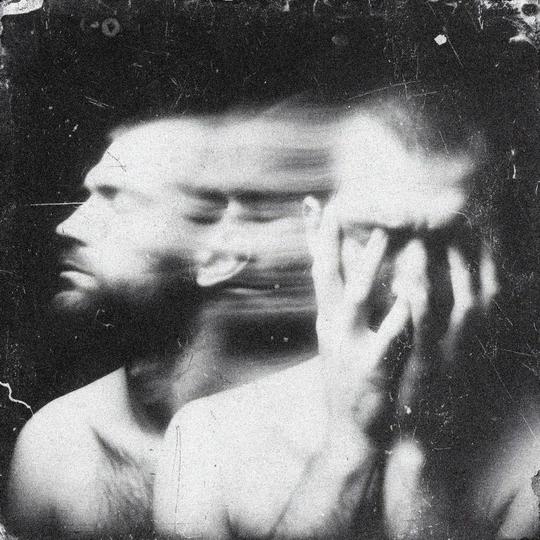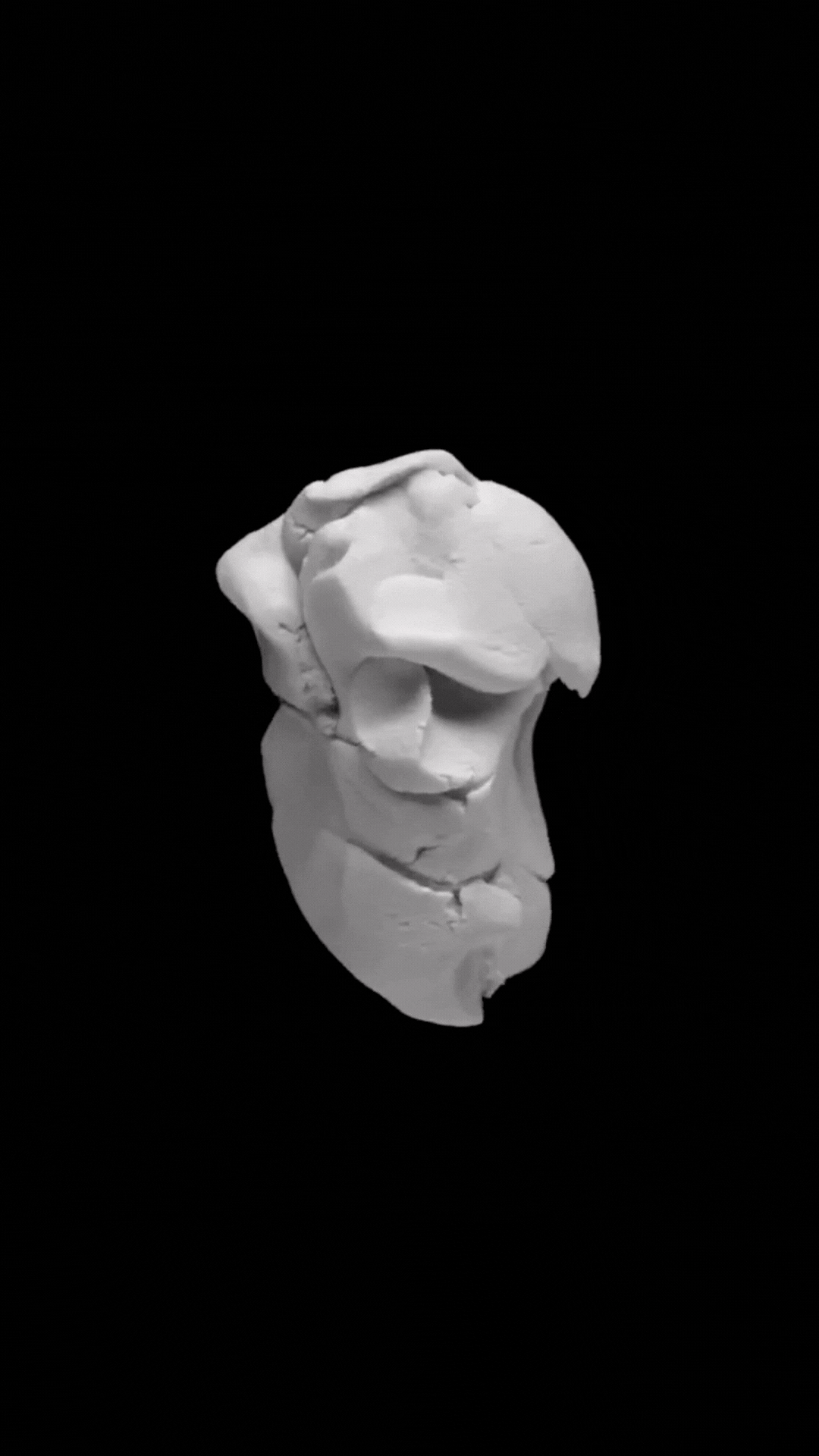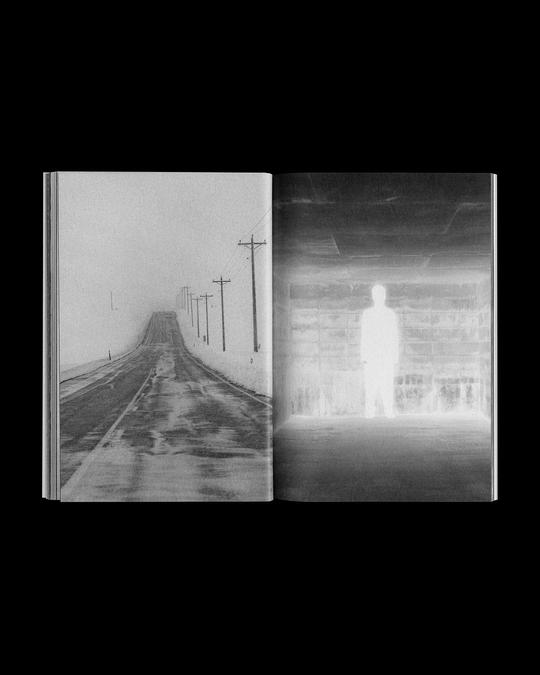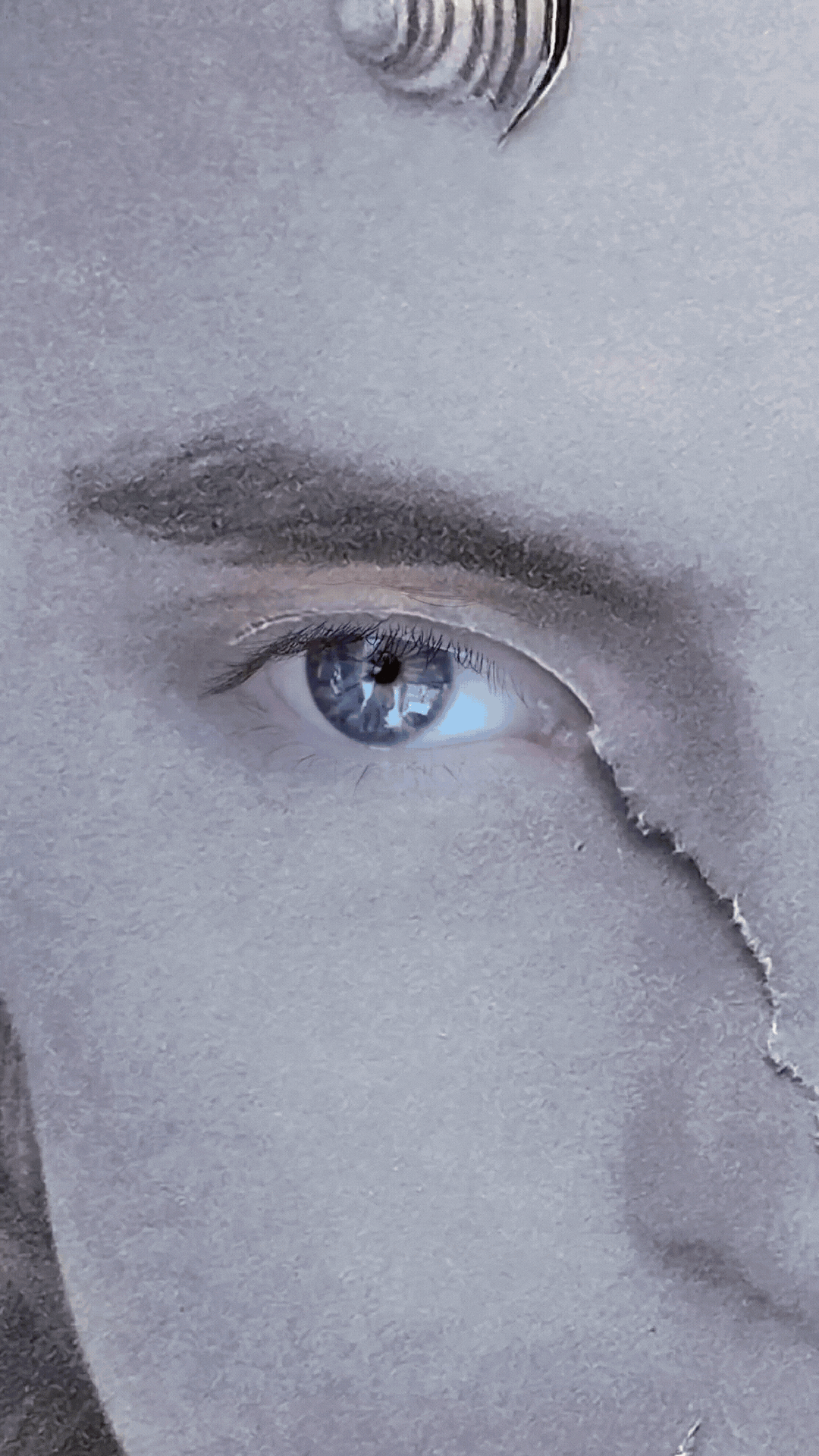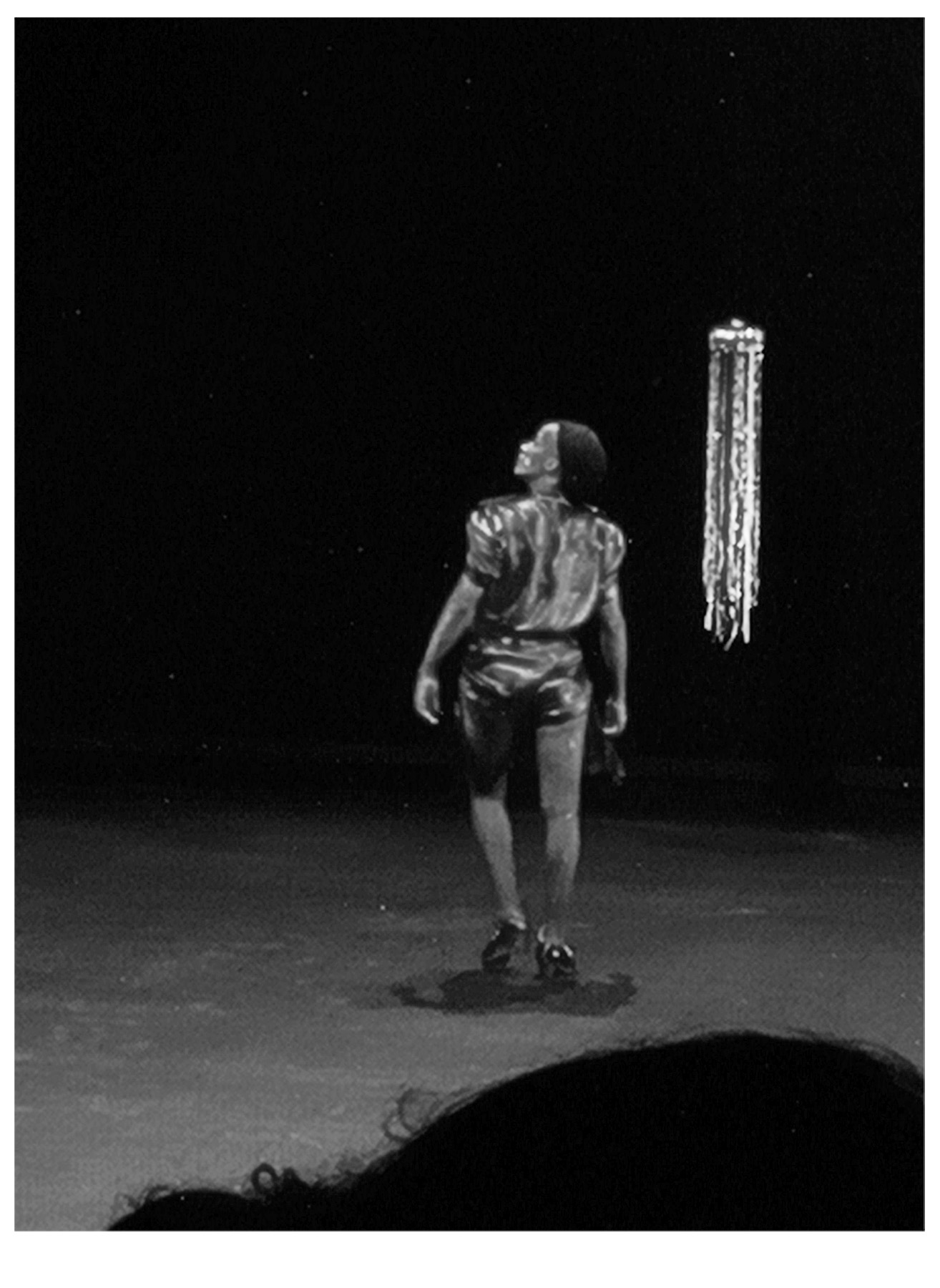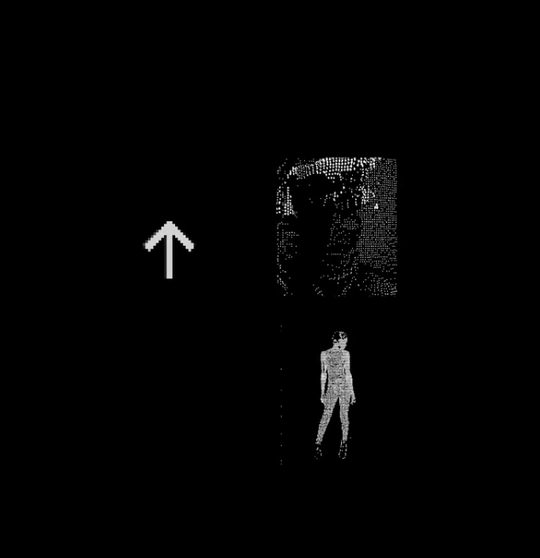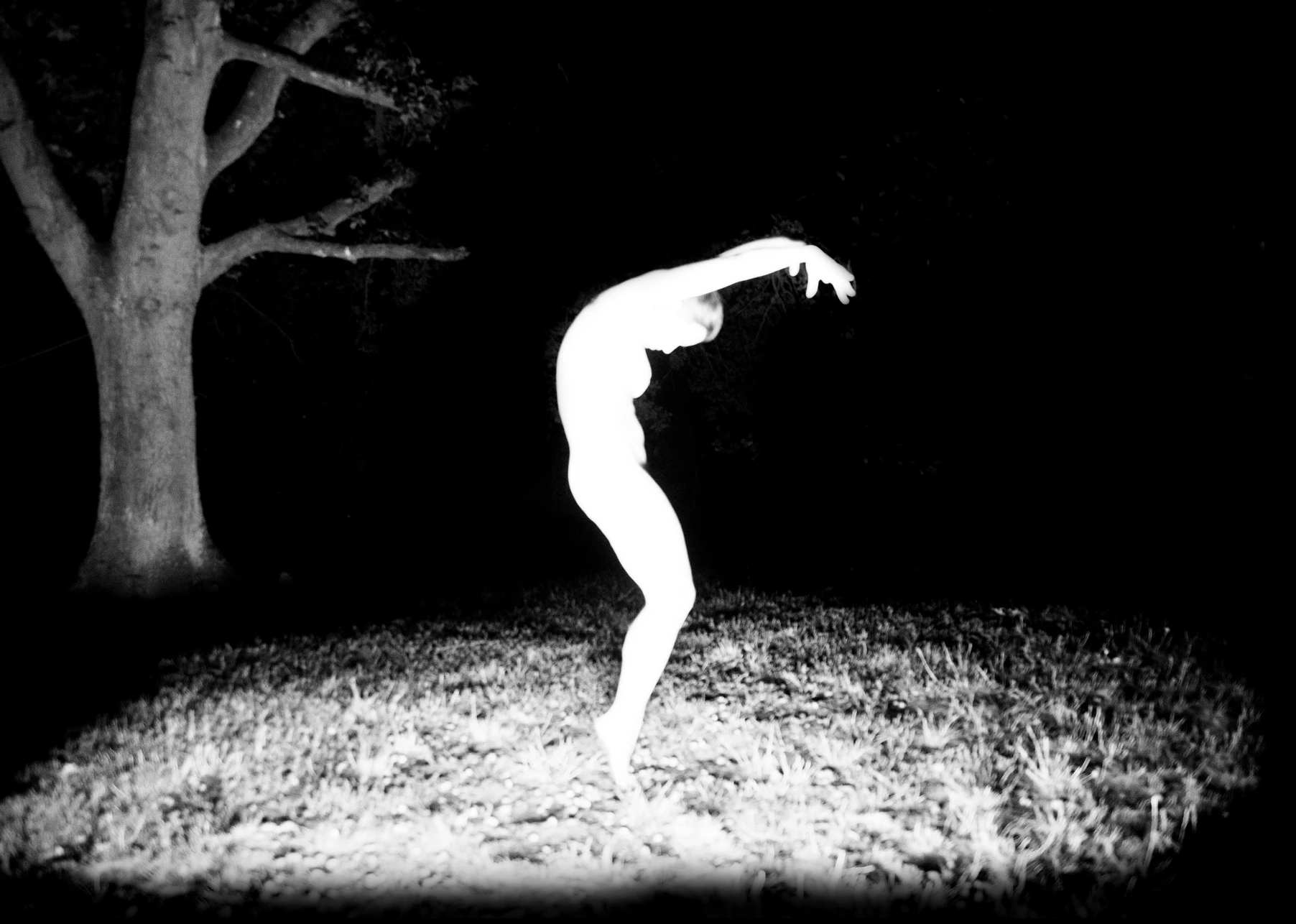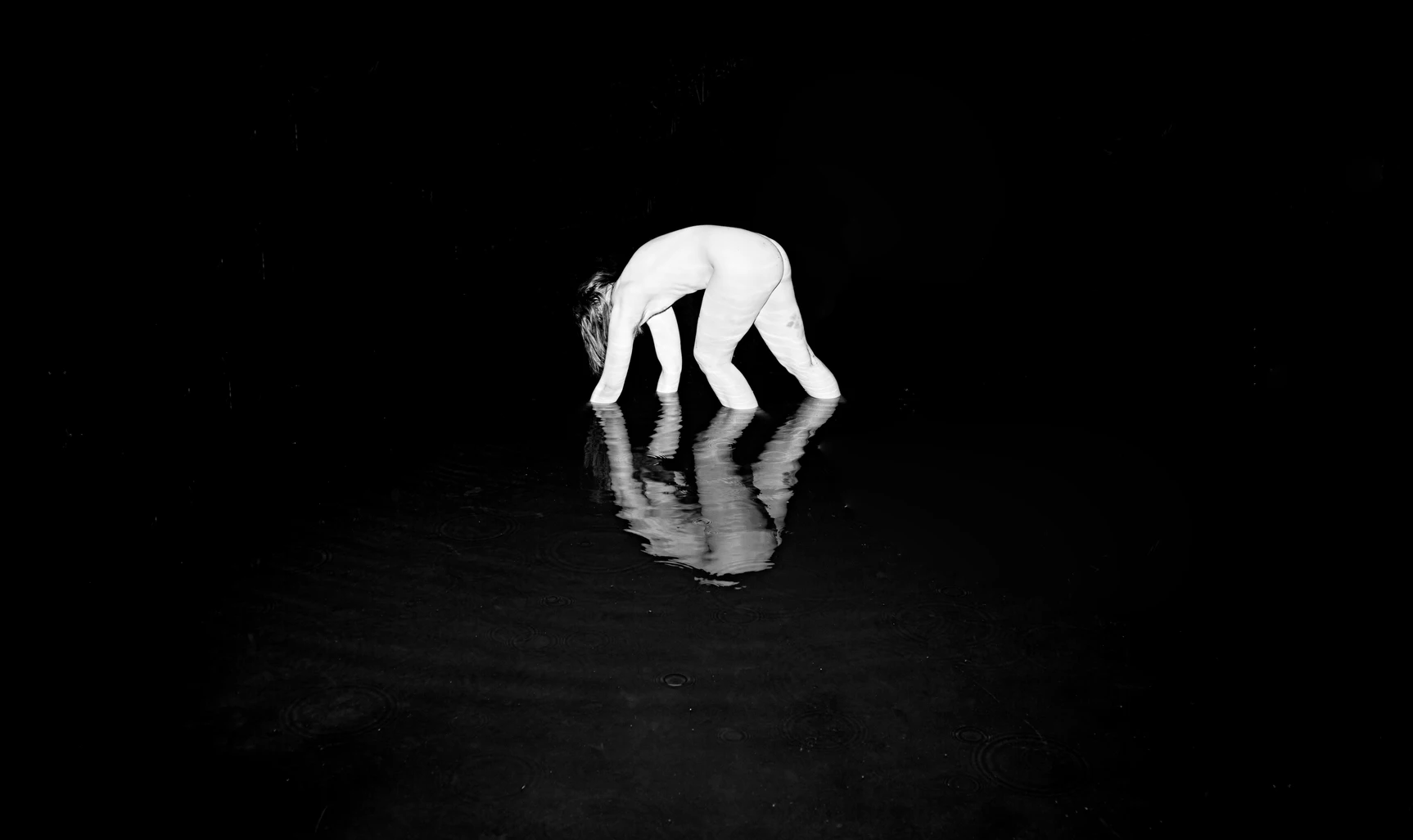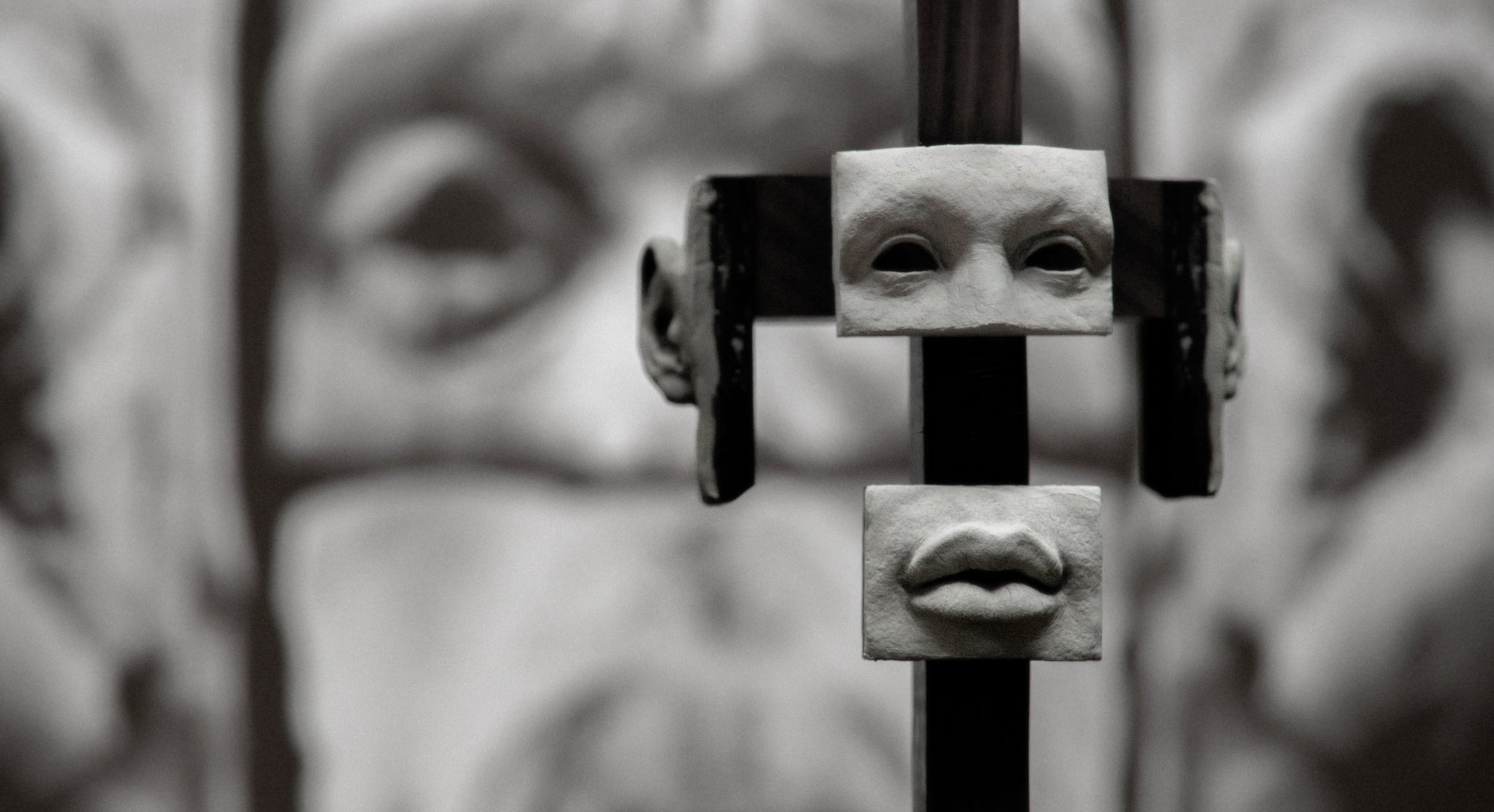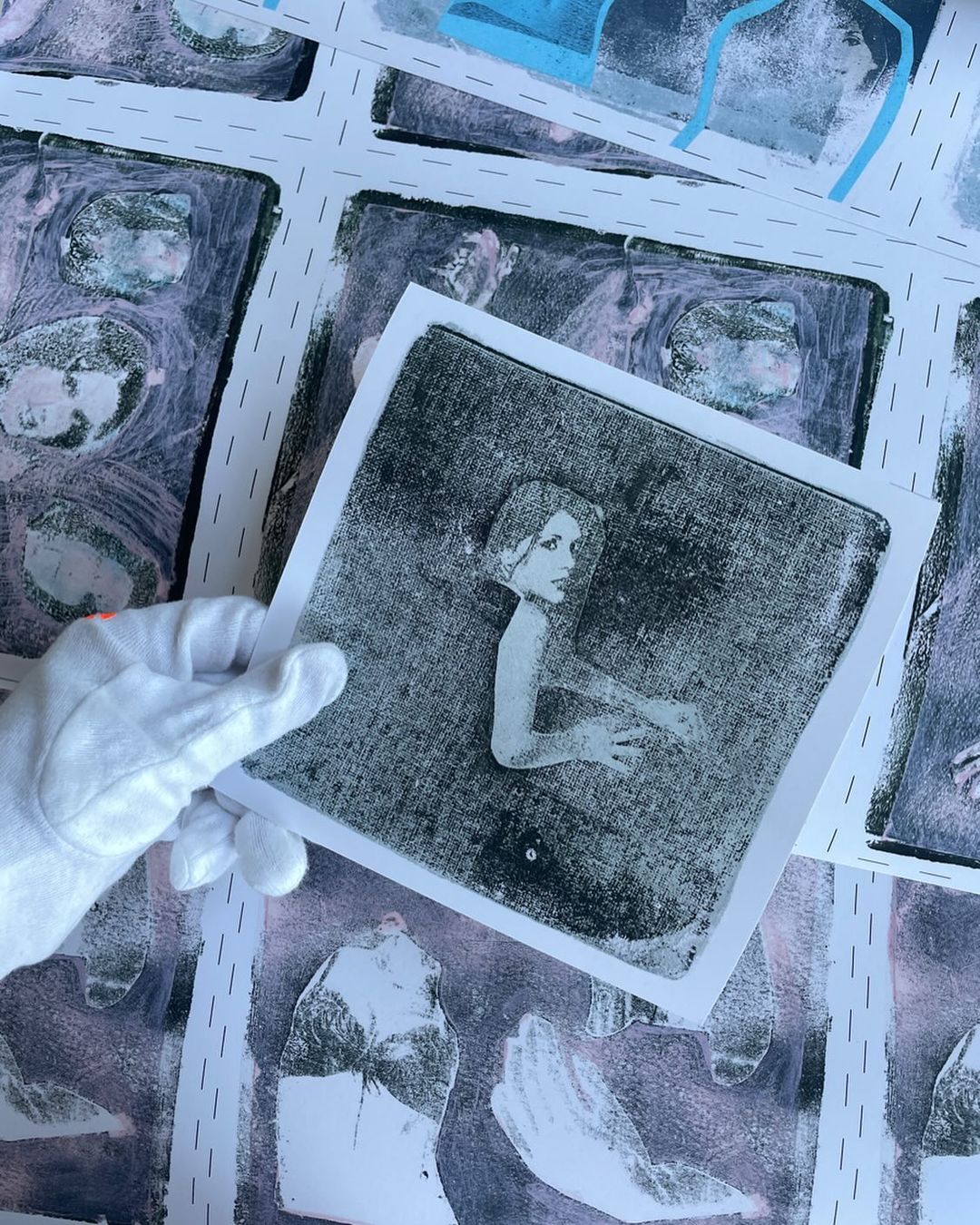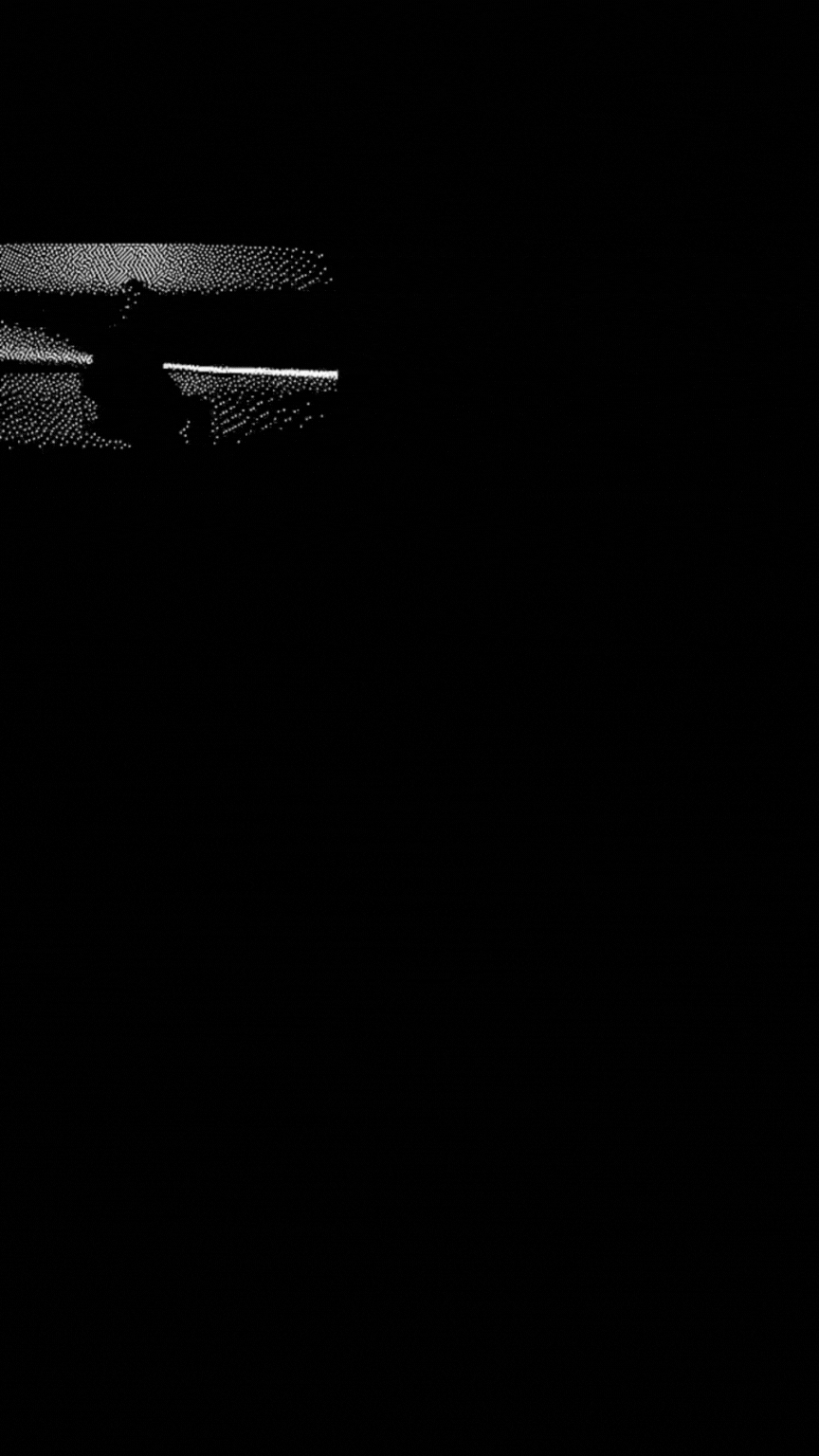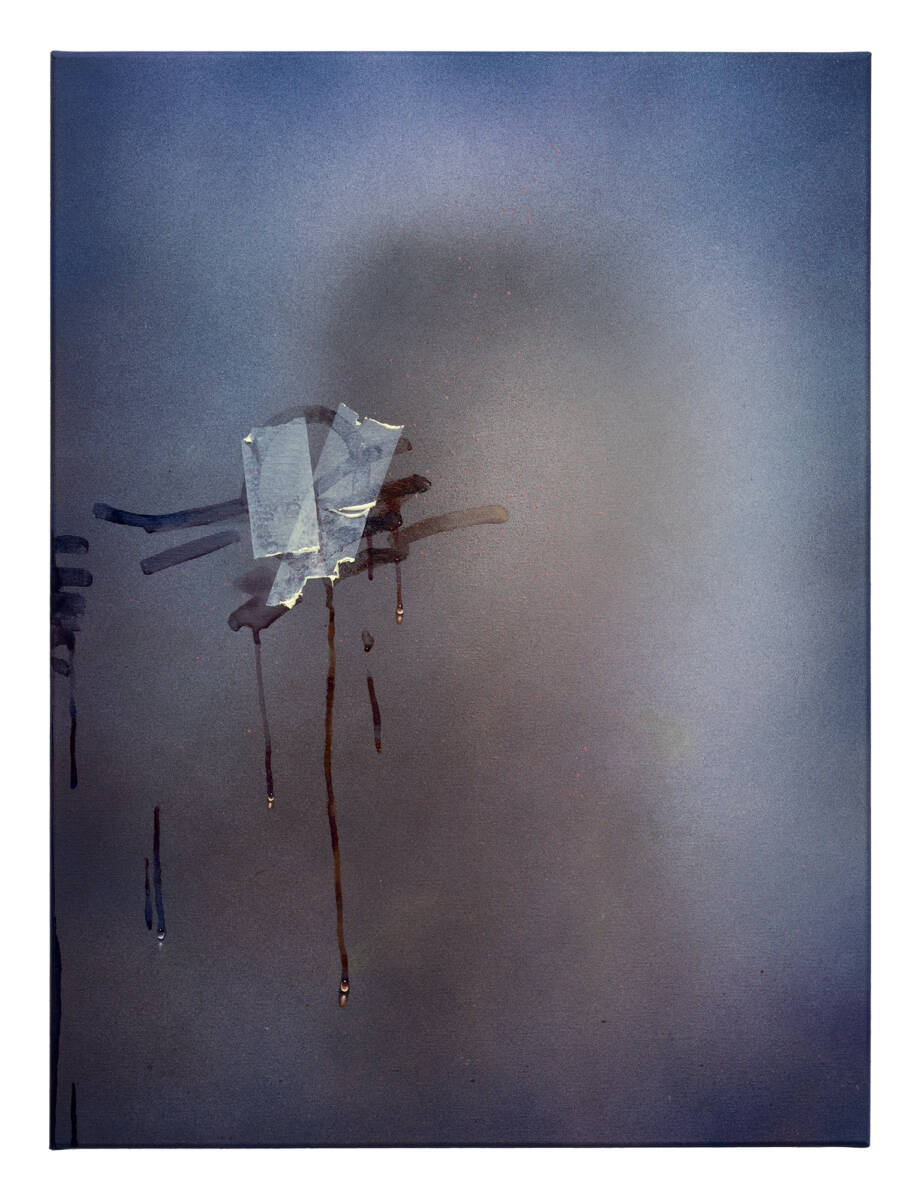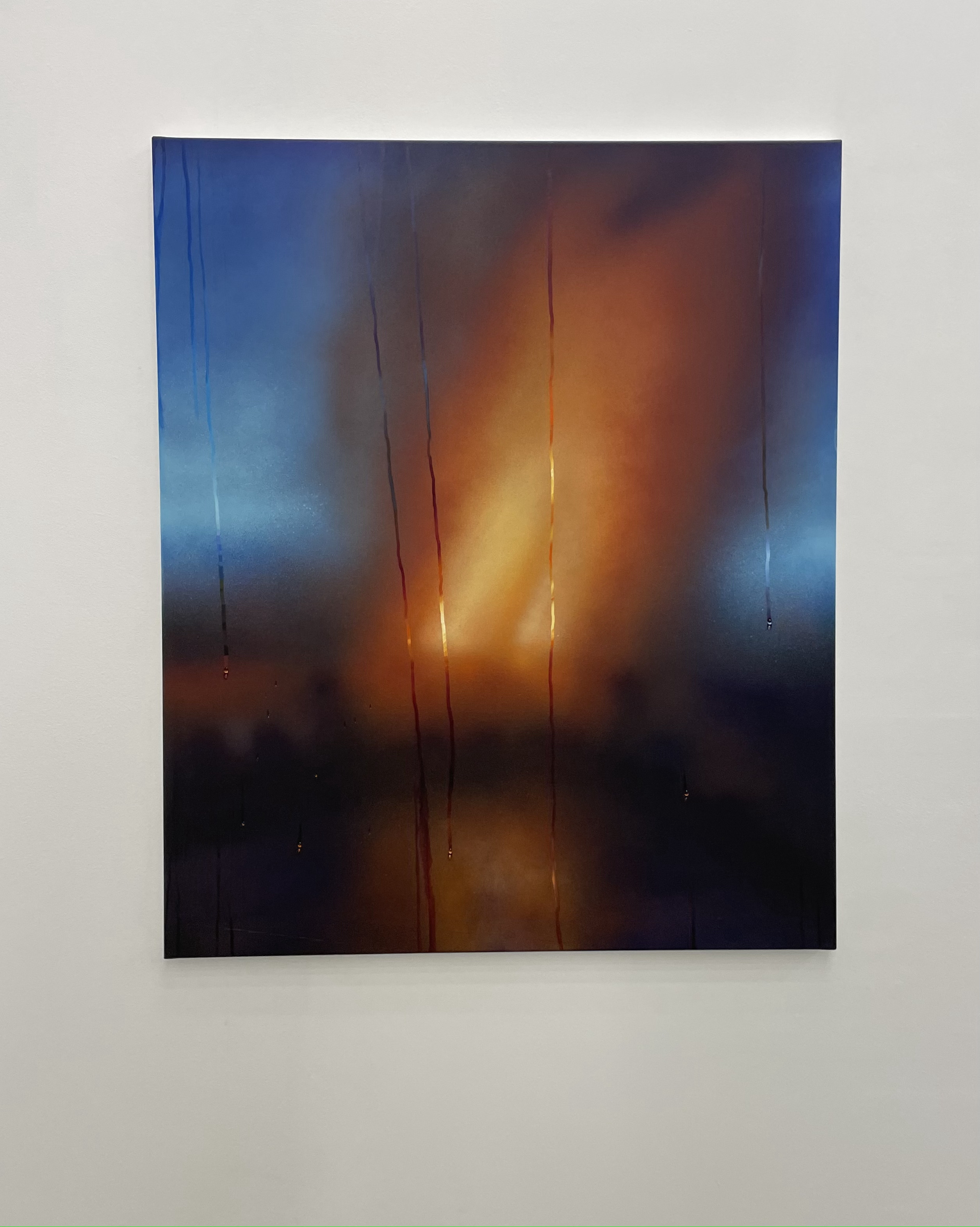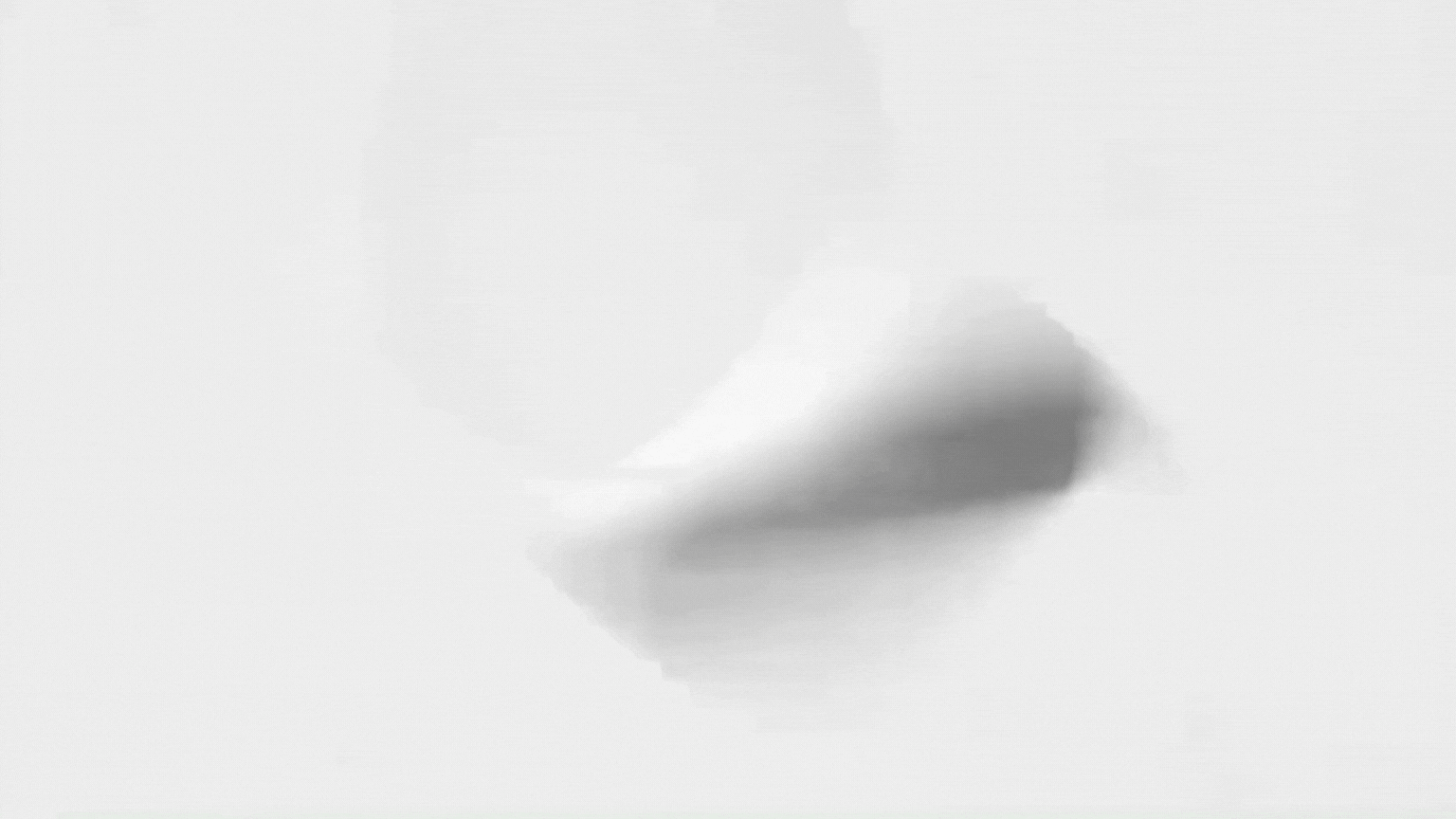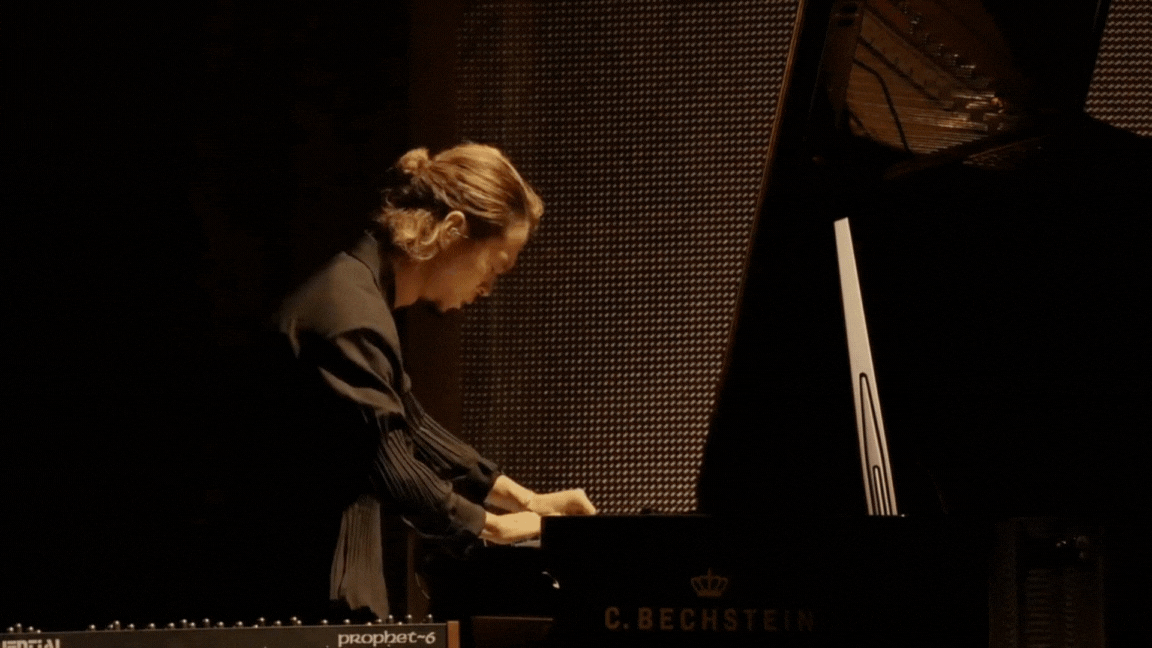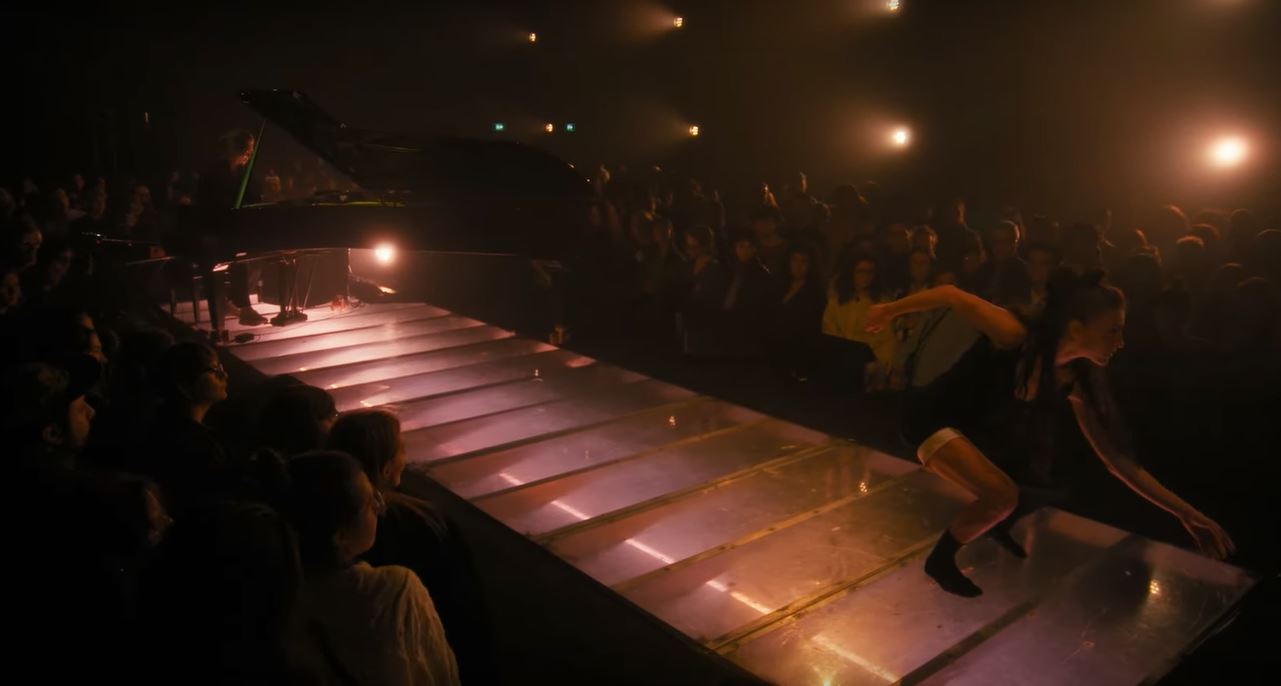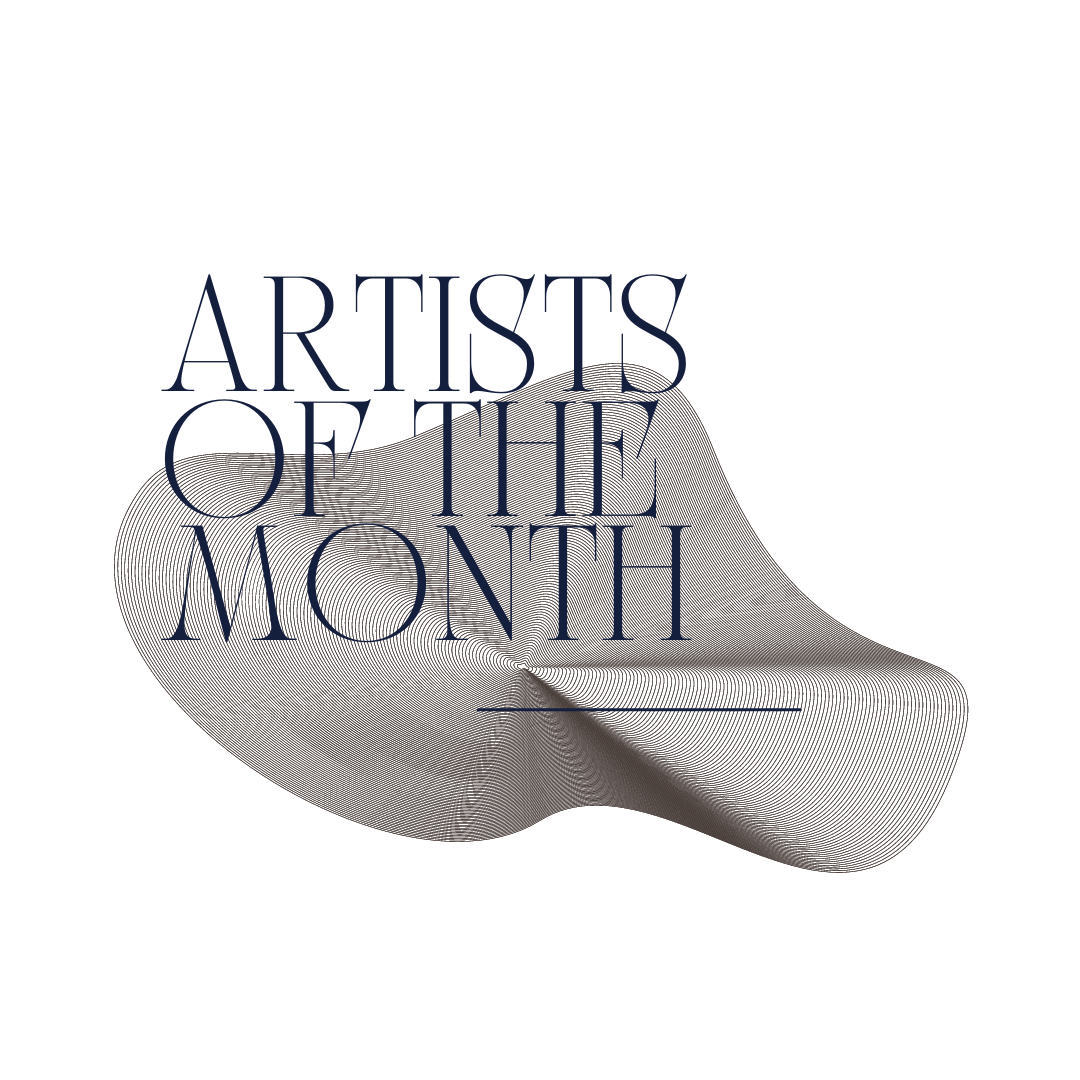
PHOTOGRAPHY
SAM EVANS
Artist review | Molly Gosewich for Blink Berlin © 2024
“…As he paces in cramped circles, over and over, the movement of his powerful soft strides is like a ritual dance around a center in which a mighty will stands paralyzed. Only at times, the curtain of the pupils lifts, quietly – An image enters in, rushes down through the tensed, arrested muscles, plunges into the heart and is gone.”
—Rainer Maria Rilke
In Rainer Maria Rilke’s “The Panther,” the poet captures the tragic confinement of the piece’s namesake, a majestic yet terrifying animal fated to a circular ritual dance — free to only perpetually pace behind bars. Rilke’s imagery goes beyond the creature itself and speaks to a sort of existential paralysis, where the confines of an environment stifle the will and spirit of a being.
Similarly, Sam Evans’ otherworldly photographic series CONCLUSUS is a visceral meditation on this paralysis, and how humanity, fascination, and fear are all perceived and relate to each other. Evans reinforces these haunting concepts by distinctly drawing an analogy between wild animals and marginalized individuals in society who might be viewed and treated as outsiders. The black-and-white photographs that make up this series, like scenes illuminated by the sudden burst of a hunting camera’s flash, reveal luminous human figures positioned in the shadows of the wilderness. This intense illumination highlights the vulnerable, totally naked body against the pitch darkness, creating a powerful contrast that brings the subject into sharp focus with immediate visual tension.
The figures in CONCLUSUS appear paradoxically confined and free; while physically unrestrained, there is an underlying unease that points to a deeper sense of imprisonment that underpins the photo series. While the figures are on display and positioned to be definitively seen, they are neither fully integrated with their environment nor entirely separate from it, reflecting the tug-of-war between physical freedom and a deeper, more insidious societal captivity at which Evans hints: a simultaneous fascination with and discomfort toward outliers. We observe from arm’s length, perhaps with some degree of admiration or curiosity but ultimately, we are either too indifferent or fearful to confront and engage on a deeper level.
While the entire collection is outstanding, it is the first photograph of the series that is the clear stand-out and stopped me in my tracks on first glance. It depicts a human figure on all fours, head bowed towards the water. The intense lighting and the clarity of the reflection in the water highlight the naked form against the darkness, creating an almost ethereal glow that emphasizes the figure’s vulnerability and essence.
Evans’ photographic gaze and use of light and shadow urge me to probe further and look longer for a more profound, inclusive understanding of identity and existence. Their visual narrative is uniquely confrontational, a rare tribute to the complex interchange of freedom and confinement. Through their photography, others and I can continue to best reflect on how we view those who are different — Evans so brilliantly highlights the tension between the desire to observe and the fear of truly seeing, encouraging a re-evaluation of societal norms and prejudices in ways I couldn’t have foreseen.
PHOTOGRAPHY
SHOO MARS RAE
Artist review | Dylan Stanaway for Blink Berlin © 2024
Shoo Mars Rae’s photography, focusing mainly on black and white portraiture, captures something vital about the human experience. The images contain people who, although seeming familiar to us, are not quite belonging to this world. Soft lines, grainy textures, and an ethereal haze combine to form a vision of another place – rooted somewhere deep within the subconscious.
Francis Bacon, a world-renowned figurative painter of the twentieth century, once said that “after you’ve been photographed, one still wouldn’t know what your realism was. You’d have to find a technique by which you can give over all the pulsations of a realism, of a person.” Through the photographic medium, Shoo Mars Rae has found such a technique to visually reproduce these pulsations.
The photographer manipulates the camera’s shutter speed to create fractured and distorted bodies and faces, simultaneously representing both the subject’s outward appearance and what Bacon refers to as their “realism.” Reminiscent of the figurative distortions found in Bacon’s own paintings, these abstractions of form give the impression of people who are torn and tortured, lost and longing, overflowing with vitality and life.
Shoo Mars Rae’s abstract portraits reveal hidden psychological landscapes, allowing us to see beyond the exterior of a person’s appearance and into their inner emotional essence. While looking through the photographer’s collection, I am confronted with an overwhelming sense of loneliness radiating from these people trapped within. I can almost hear the faint sounds of their voices, calling out for anyone who might be willing to acknowledge their presence. However, they remain alone within the compounds of their own composition, a solitary island existing in a singular moment suspended in time, and are destined to stay that way as long as the photograph endures.
sculpture
JUSTIN M ZIELKE
Artist review | Niklas Ranze for Blink Berlin © 2024
Justin M. Zielke's quote, 'Exploring themes of identity and our hyperfocus on qualities we want people to see,' perfectly encapsulates his captivating multidimensional approach to art. He transcends the label of mere artist, emerging as a masterful storyteller. Through his work, Zielke intricately weaves tales of identity and perception, effortlessly drawing viewers in from the very first glance. Whether sculpting or crafting videos, Zielke effortlessly dismantles conventional barriers, immersing audiences in experiences that resonate deeply with the essence of humanity.
There's an undeniable fluidity to Zielke's creations, a harmonious marriage of traditional craftsmanship and cutting-edge technology that breathes life into his visions. His art transcends mere surface appearances; beneath the visible lies a wealth of layers, akin to hidden treasures awaiting discovery.
His sculptures are like emotional and existential puzzles, each curve and contour inviting you to explore the depths of your own soul. Using a mix of materials such as clay, metal, wood, and techniques including carving, molding, and casting, Zielke captures the subtle nuances of human expression, especially in the face, where every line tells a story waiting to be discovered.
Immersing yourself in Justin M. Zielke's 'Render Tiles' can evoke a powerful range of emotions and experiences. You may find yourself drawn into a world where traditional boundaries of form and structure are challenged.
The fragmented and deconstructed faces, meticulously crafted from plaster and charred wood, may initially appear disjointed and unfamiliar. Yet, as the dynamic video projection dances across the textured surfaces, a mesmerizing transformation begins to unfold before your eyes. It's as if the faces are slowly assembling themselves, revealing layers of emotion and expression with each passing moment, reminiscent of the intricate detail of a Venetian mask.
What's truly captivating is how, in every passing second, the face changes its quality and appearance. It's as if the face itself is never a rock-solid object but a fluid entity that evolves and reveals itself the more we look at it. This dynamic quality of the artwork invites us to ponder the essence of art itself – the unraveling of a single face that encapsulates infinite qualities and different faces. The idea that he films the process of creating the sculpture and highlights this process means we see this evolution firsthand, adding another layer of depth to the experience.
While you watch, you might feel a sense of curiosity and wonder, as the intricate play of light and shadow invites you to explore the depths of each face. This interplay, combined with the materiality and corporality of the clay, not only captivates the eye but also reveals the different nuances of the face by highlighting various angles.
In moments of profound introspection, Zielke's fragmented creations mirror the intricate complexities of your inner world, beckoning you into an uncanny exploration of your self.
While you gaze upon these enigmatic faces, a visceral connection ignites within you, resonating with primal intensity. It's as though your own face is looking back at you, unsettling yet strangely familiar. Are you beholding your reflection, or has Zielke sculpted the essence of another's soul? This tantalizing enigma intensifies the visceral connection, immersing you in a captivating dance of uncertainty and revelation. Uncertainty lingers, blurring the lines between sculpture and your own visage.
Each meticulously crafted detail pulses with the artist's mastery, laying bare the essence of your being. It's a mesmerizing fusion of artistry and technology, evoking an aura of profound mystery and uncanny familiarity.
Ultimately, 'Render Tiles' becomes more than just a video installation — it becomes a transformative journey that unfolds within the confines of your screen. It prompts reflection on the intricacies of human identity and invites you to contemplate the timeless mysteries of the human condition, all from the comfort of your own digital space.
At its core, Zielke's art is about capturing the fleeting moments that define us as human beings. It's about diving headfirst into the messy, beautiful chaos of life and coming out on the other side with a deeper understanding of ourselves and the world around us.
So next time you find yourself face to face with one of Zielke's creations, take a moment to really look. You might just discover something about yourself you never knew was there.
dance performance
YINKA ESI GRAVES
Artist review | Dylan Stanaway for Blink Berlin © 2024 | Photography | Aoife Carolan
Since 1989, Tanz im August brings local and international productions to audiences in selected locations across Berlin.
This year – one of the acts presented at Hebbel am Ufer is 'The Disappearing Act' by Yinka Esi Graves, British dancer and choreographer. On stage, the artist executes el baile flamenco, the flamenco dance, combining elegant and commanding movements with hypnotising rhythmic footwork. Raúl Cantizano acts as musical director and guitarist. His score blends ambient drones with virtuosic flamenco-style playing. Remi Graves supplies a driving percussion accompaniment. Rosa de Algeciras, providing the show’s cante component, delivers a vocal performance that wavers, soars, and intoxicates.
At its surface, the performance is a showcase of the masterful execution of flamenco movement, rhythm, and song. However, underneath this surface lies the show’s predominant theme – the hidden contributions that African communities have made to the evolution of the flamenco art form. Under this lens, Graves examines her own personal experiences of finding her place within the flamenco community as a person of African descent. The performance is punctuated by a number of symbolic theatrical elements that elude to Graves’ search. Midway through the performance, the dancer stops to ceremoniously apply a full face of makeup to conceal her true identity, just as history has often concealed the cultural significance of African heritage, while her sibling Remi Graves recites an eloquent poetic verse relating to their Ghanaian ancestry.
Another particularly striking moment occurs when, with a piece of chalk in each hand, the dancer traces out intricate lines and curves on the floor of the stage. These geometric forms seem to suggest the repetitive and structured process involved in learning the steps of the classical flamenco style, a pursuit which seeks to uphold authenticity and tradition. At first the dancer seems to move carefully over these predetermined lines, adhering to the conventional approach to studying the art form. As the performance progresses, however, she gradually moves further outside of these rigid structures and takes on a path of her own, a path where she can express herself freely. Through this act, Graves is able to show us how flamenco relates to her own personal and cultural perspectives.
The Disappearing Act reminds us of how African cultures can become overlooked, ignored, and eventually forgotten, vanishing beneath the subjective truths that form predominant historical narratives, particularly those rooted in colonialism.
The performance recognises the many forgotten contributors to art and culture that have enriched the world we live in today, seeking to shed light on the erased history of these communities before their stories become lost in time forever.
mixed media
RANDON ROSENBOHM
Artist review | Molly Gosewich for Blink Berlin © 2024
After visiting Ukraine’s Carpathian Mountains and seeing an icon of Mary breastfeeding the infant Jesus, Randon Rosenbohm promised herself (and God) that she would start creating again after a personal hiatus. Born in New Orleans and now residing in Berlin, Rosenbohm is an astrologer and artist. She has been painting since childhood and graduated from the Scuola di Arte Sacra in Florence, Italy – praying five times and day and living amongst nuns. But living in Berlin, a city of rebellious teenagers and Protestantism, required some adjustments to make room for her religious life (she was confirmed while completing her degree, even flying from Florence to Berlin for the Pentecost) and practice of creating devotional images. Now, the physical form as a symbol shows up in her present work, which is engaged heavily with feminist themes, history, and spirituality.
As a departure from religious art, Rosenbohm has tapped into what she references as feminine “pre-Christian goddess cults and the Jungian Shadow of porn addiction” – perhaps symbols and archetypes that some can relate to on an unconscious level. The central motif of this unnamed collage, the female figure, suggests both the sacred and the profane. Said female figure, seemingly bricolaged from different Playboy magazines, bears traces of their mass media origins. Here, her torso is adorned by a lacy red bra and a sparkly belly button piercing. Her face, not belonging to the same body, gazes out seductively and like an erotic Frankenstein, is connected to a blonde’s upper body where the actual right arm should be. The body parts are literally sewn together with crude stitches along the edges where their images intersect to create a whole through fragmented anatomy, suggesting the artificiality with which women are often depicted, not uncommon for said mass media origins. The background is an industrial setting with visible pipes and chains, a stark contrast to the vulnerability of the human forms. The color palette mixes the vibrant skin tones of the model cut-outs with a darker, moody background, emphasizing the figure against its surroundings and highlighting the tactile quality of the stitches and black markings.
The overall feeling of the artwork is jarring and provocative, eliciting instant curiosity and discomfort while warranting introspection. The crude stitches that bind the figure together evoke a visceral reaction, making me acutely aware of the constructed nature of identities. The sensual eroticism, along with a rabid sense of grotesqueness, creates a tension that makes it difficult to reconcile these conflicting elements. Certain areas of the collage, particularly the torso and chest, are obscured and marked with black patches, which also makes me question what beyond the superficial is hidden and why.
In this way, Rosenbohm’s collage serves as a visual meditation on not only the body and the taboo, but also the intersectionality of themes oft considered disparate. In reflecting on meaning hidden beneath the surface (or behind black marker), I was forced to consider the ways in which collective archetypes and personal narratives intersect and inform one another.
The blending of disjointed iconography and elements with Jungian psychology, which informs this work, creates a narrative that confronts perceptions of femininity, spirituality, and cultural symbolism.
In doing so, Rosenbohm has prompted within me a not-yet-finished inner discussion about the nature of representation, the power of symbols (religious or otherwise), and the complexities of human (female) experience. Thus, her work transcends aesthetic exploration to become a profound consideration of the archetypal notions that some of us dare to question.
mixed media
JAŠA MULLER
Artist review | Molly Gosewich for Blink Berlin © 2024
Much like how Andy Warhol's polaroids captured the faces of cultural icons and served as his “pencil and paper,” Ljubljana-based photographer Jaša Muller’s images function as the basis for his own conceptual, mixed media work. Muller blends photography with fine art elements and mixed media techniques, a clear affinity for experimental imagery, texture, and striking contrast.
His most arresting visual compilation begins with a brief shot of a blue eye staring out and blinking mechanically before shifting to an egg marred with cracks like a Grecian statue. Next, the video abruptly jumps to a quickly-cut assemblage of faces and bodies—models with pale and silvery skin, red and heart-faced or adorned with snails, feathers, star cut-outs, and delicate minimalist paper collaged, overlaid, or morphed with the visage as one. Two figures square up to box, pom-poms instead of gloves. A model holds up a strung bow fashioned out of a thorned rose stem. The surreal montage is over before it ends, unfolding as ‘Heavenly’ by Cigarettes After Sex plays—a fitting musical choice for such a hypnotic scene.
The cuts between shots are fast, a blink-and-you’ll-miss it fast. So much so that I find myself nearly entranced and replaying the short video over and over. At first glance, I am brought back to, almost intensely preoccupied by, eras before my own. I reminisce of Laura Palmer of 1990s Twin Peaks fame and the sparse, industrial yet saturated look and glacial melancholy (and makeup) of the New Wave era. But of course, as a photographer of dualities and multitudes, there is a distinction between Warhol and Muller’s gaze. Warhol’s models are warm, natural, confident, and coy, while Muller vividly captures faces with an avant-garde, surreal, icy, yet angelic essence. It is no surprise Muller has also photographed figures like French musician Christine and the Queens with the same kind of vision.
Muller’s distinct focus on the centrality of the face and body results in inimitable and captivating images that fall in the grey area between photograph and painting, universalism and individuality, dream and reality, light and darkness, solid and liquid.
Through his approach, Muller not only pays homage to the tradition of photography but also pushes its boundaries by freely mixing materials, mediums, and styles, creating a visual experience that both challenges and enchants.
His work might invite a deeper contemplation of the human condition and figure, the nature of art, and the ever-shifting landscape of visual culture. In doing so, Muller establishes himself as a character to watch in the realm of contemporary photography, continually redefining the possibilities of the medium.
digital art
SAFE HAVEN
Artist review | Dylan Stanaway for Blink Berlin © 2024
The work of Los Angeles-based graphic designer Safe Haven is as enigmatic as it is dark and foreboding. The artist's visual style and choice of provocative imagery, showcased in short-form digital animations, is implicitly Orwellian in its nature. A work published by the artist on March 29th of this year, set to the raw electronic sounds of Eprom's Motion Blur, lends itself particularly well to these dystopian interpretations.
In this piece, the artist presents a reality that has been reduced to its binary counterparts. Familiar depictions of human faces and bodies appear as monochromatic formations of pixels alongside inherently digital imagery: scripts of code, user interfaces, 3D graphical renderings.
By combining what we consider to be real and tangible with such fundamentally digital concepts, the artist seems to suggest that humanity is in the process of becoming submerged in a world that is virtual to its core.
"So have you decided which path to take?" These resonant opening words stay with the viewer throughout the duration of the piece. Here, the artist appears to be presenting us with an ultimatum: either remain in a state of passivity as the world rapidly evolves around us, or to begin to consider the implications of a future where society and culture occupy a virtual form.
Safe Haven offers us a glimpse into a world where every decision we make, every thought we express, becomes part of a collective virtual existence. However, the artist's work reminds us of what this world can be: a place for creative expression, where we as individuals can become architects, rather than just consumers, of the virtual environments that we are coming to inhabit. Once we come to terms with this, we can begin to uncover our sense of purpose as citizens in such a society.
PAINTING
JOCHEN MÜHLENBRINK
Artist review | Niklas Ranze for Blink Berlin © 2024
"J’M donc je suis" – Jochen Mühlenbrink's
latest monograph title not only encapsulates his artistic journey from
2018 to 2023, but also means the French translation of “I love”:
“J’aime”. These two letters articulate the essence of an artist who
revels in life, embraces love wholeheartedly, and cherishes the pictures
own existence to the extent that he welcomes their ambiguity and enigma
– in short, the very essence of their being, with all its intricacies
and uncertainties.
In a world where clarity is ever more elusive, akin to gazing through transparent glass, his art wrestles with the complexities of perception, encompassing its blind spots. This entails acknowledging the worlds blurriness, invisibility, deceptive transparency, and visibility. His images address the mounting opacity of our environment by paradoxically rendering opacity as opacity visible.
These adventures of perception form the core of German artist Jochen Mühlenbrink's work. Born in 1980 and a graduate of the Kunstakademie Düsseldorf under the mentorship of Markus Lüpertz, his style resonates with photorealistic imagery, reminiscent of artists like Gerhard Richter, Gregory Thielker and Riona Buthello. Mühlenbrink's paintings, executed in a Trompe-l’Oeil (“deceive the eye”) style, heighten the hyperrealistic sensuality of the world by deliberately obscuring clear or familiar imagery.
For his images, there is no
one-size-fits-all approach. Each material must be selected for each
painting and picture cycle, guided by intuition through the foggy
process of creation. However, he primarily prefers working with
acrylics, oils, and resin, using wood, paper, or canvas as his chosen
surfaces for most of his artworks.
What's paramount in his material selection is that he opts for materials that not only engage our sight but also beckon us to touch and feel his images.
We had the delightful opportunity to attend the opening of his latest exhibition BCP at the ASPN Galerie in Leipzig. We wholeheartedly encourage everyone to immerse themselves in the enchanting world of his paintings and unravel the intriguing puzzles of perception that his images evoke.
As I wandered through the exhibition Saturday afternoon, I felt a mixed set of emotions swirling within me. The gallery was crowded, a lot of people were laughing joyfully around me with excitement in their voices and smiles. They might feel the same as I do. A lack of certainty of what to see and feel.
The deep blues and fire red shades in Mühlenbrink’s newest painting, WP BCP and WP BCP (Drop) stirred up feelings of unease and nostalgia, casting a captivating spell over the pictorial space in front of my eye. I see a background on which the objects are burning, but it is not clear what they are. They might be a car, a house, or just a campfire – maybe something even more uncanny.
I can’t see through the window since my gaze is covered by the milky surface. Only through small paths on the surface, opened by water drops, my gaze can unravel the background and its hidden secrets. But what is it? Is it something I’ve seen in my childhood, something that I believe I’ve seen, or just something my mind makes up now? I can’t tell for certain.
So, despite my curiosity and eagerness to unravel the mysteries hidden within the artwork, I found myself unable to penetrate the surface of the canvases. I can’t find out what was behind the window, behind the illusion I sensed. Yet, amidst this uncertainty, there is a profound beauty and joy — not just intellectual, but corporal, emotional joy – in the enigmatic nature of his art.
What truly made my trip to the ASPN Galerie in Leipzig unforgettable was the presence of Jochen Mühlenbrink himself, with whom we had the chance for an interview. In this immersive dialogue, we gained many thoughtful and creative insights into his art and artistic world. Our encounter sparked an electrifying conversation about art and his mesmerizing works on display, an experience I carried all the way back to Berlin.
Dive into the captivating exchange below in our exclusive interview.
PHOTOGRAPHY
FRANCIS KANAI
Artist review | Niklas Ranze for Blink Berlin © 2024
Photographer Francis Kanai, hailing from
Takasaki, Japan, and poet Malaya Malandro, residing in Los Angeles,
USA, join forces in a unique collaboration that lead to their book
“Everything is a Self-Portrait”, published in 2023. Beyond simply
working together across different artistic disciplines, their
partnership underscores the convergence of two distinct perspectives on
interpreting the world: photography and poetry.
In
both the poetry of Malaya Malandro and the photography of Francis
Kanai, there is a concerted effort to capture the fleeting emotions of
contemporary times. Through their respective mediums, they reflect the
complexities, anxieties, and ambiguities of the modern world.
In
"Everything is a Self-Portrait", Kanai and Malandro explore the
fundamental question: How does meaning emerge in the world? Rather than a
static entity waiting to be discovered, sense is an ongoing process,
continually evolving as we engage with our surroundings. In essence, we
actively construct sense through our relationships and experiences with
others.
Art, therefore, embodies this process of sense-making, reflecting shared experiences and perspectives.
Through collaboration, unique artworks are born, transcending what each individual could achieve alone. Collaboration, as a form of shared experience in art, represents an impossible gesture for those in isolation. Art becomes a testimony to the intertwining of singular and plural perspectives with the world by blurring edges and filing blind spots of the others perception, leading them to explore the concept of the "unending self" — a notion that speaks to the interconnectedness and continuity of human experience.
Reading "Strawberry Cigarette" by
Malay Malandro while gazing at Francis Kanai's photograph evokes a
visceral experience of tension and ambiguity. The poem's intense
atmosphere, depicting a heated exchange between lovers, contrasts with
the divergent situations captured in Kanai's photographs.
In
the poem, the heated dialogue between the lovers, coupled with the
absence of a response from the other, intensifies the sense of conflict
and emotional turmoil. The lines "You are the 100 hollow eyes I have
seen before, wearing the dry mouth of a lonely person" evoke a sense
of longing and bitterness, hinting at the complex dynamics between the
self and the other.
Her words resonate with the
emotional turmoil and existential angst that many individuals experience
in today's fast-paced and uncertain world. By tapping into universal
human experiences, Malandro's poetry serves as a poignant commentary on
the human condition in the contemporary era:
Examining Kanai's photographs adds another layer of complexity to the narrative. The image of two men sitting back-to-back in what appears to be an airport or train station conveys a sense of disconnection and isolation, mirroring the themes of loneliness and longing present in the poem. On the other hand, the image of the naked male body and the female hand holding a cigarette in a car suggests intimacy and vulnerability, juxtaposing the distant and detached mood of the previous image.
However, the absence of facial
expressions in both the poem and the photographs spark a gloomy and
enigmatic quality of intersubjective experiences. Without the ability to
discern the emotions behind the characters' gazes, the viewer is left
to interpret the scene based solely on body language and context,
inviting them to project their own feelings and experiences onto the
narrative.
Through their art, they provide a mirror to
society, encouraging viewers to confront and engage with the complex
tapestry of emotions that characterize the world we live in today.
COMPOSITION
KOKI NAKANO
Artist review | Niklas Ranze for Blink Berlin © 2024
"How you touch or you want to touch the complexity of the world". This is the self-given definition of art by the Japanese born composer and pianist Koki Nakano. His belief is, that there is a primordial harmony – a flux of life – that our culture has forgotten but that inspires us every day. His music is an attempt to unfold and reconnect to this harmony.
It isn't a real surprise that Nakano composed and perfomed live the original music for the Issey Miyake AW collection 2024/25 "What has always been". Since Nakano‘s fascination for bodies and their movements and shapes is well known, it makes him the perfect match for art that creates clothes, the second skin of human kind.
Issey Miyake's fashion is known for its contemporary design, for its innovation and playful connection of different materials, and for its fluid shapes. This connection between music and clothes, marks another aspect of the introductory quote that highlights Nakano's holistic artistic approach. Clothes are an integral part of our daily lives, and they transcend the pre-given and static boarders of our sensible body.
Nakano maneuvers on the edges of classical and electronic music. His music is mysterious and opaque as if you must constantly follow the traces the sounds have left on the soil. But at the same time, it’s clear and transparent. On the one hand the piano chords are smooth, tentative – questioning and sensitive. On the other hand, vigorous and precise, diving deep into the innards of his instruments: the piano and the synthesizers. Always together, they flow into the harmony of the world he wants to express.
The best way to experience the art of Nakano is undeniably to visit one of his extraordinary performances accompanied with contermporary dance. One that stood out to me is his concert in Paris four months ago, accompanied by the choreographer and dancer Tess Voelker.
This concert gives me the feeling of the cycle of a day, beginning with the sunrise.
A very dimly lit stage and slow, peaceful light enlightens the piano and the synthesizers that lay inside the open body of the piano. Nakano is calm and in a spiritual mood, prepared for what will happen in the next hour. He builds up smoothly his intro, with clocking and ticking sounds like an alarm clock ringing in the morning. A wake-up call. It’s time to wake up. In between these drippy, ticking and clicking sounds, there is a sound that reminds me of the scream of a newborn baby. Everything is set up for a birth or sunrise—a new beginning.
Then, after the climax of the electronical rise, the piano starts playing. The electronical sounds fall into the background, whispering, and the piano enters the stage. Calmly and with his eyes shut, he touches the keyboards, and bright sounds echoing through the room.
After the intro of the first song, which sets the atmosphere for the evening, Tess Voelker appears on the stage. In the red and orange light of the morning, she moves across the stage with swirling and trembling movements. Her dance visualizes the music, the body resonates with the music Nakano is playing, and the music itself makes the dance hearable.
Her body postures moves along the music, or does the music move along her movements? You cannot tell. The intertwining of sound and dance comes to «zone of vagueness» where you can’t differentiate between what comes first and what follows. Music and dance create a situated unity of two poles of expressions.
After about 13 minutes, the light color changes. The red, gloomy light gives space to a colder, blueish light. We reach the climax of the sun and the day. It’s indeed not a summer day. It’s more like, since the concert is held in November, an autumn or winters day. Likewise, with the weather and the temperature change, the sound of the synthesizer becomes frostier and icier as well, and Tess Voelkers movements become sharper and extended through the room, growing like stalagmites in a cave.
At minute 26, the color changes again from blue to red. The sun sets and music becomes more joyful, sparkling and faster. And so do the movements of Tess Voelker become lighter, accelerated, yet more excited. At the end—the last 15 minutes – Nakano is left alone on stage and performing.
He closes the circle of the day and the concert by playing one dreamier and one more impulsive song. The light also becomes darker, yet more mysterious like the night in which we fall when we go to sleep.
What we experience by watching and listening to this musical and corporal arrangement is the natural flow of everyday life and of the ordinary world; the different tempi and rhythms that bodies express resonate throughout their musical corpus. It’s the flow from which his art arises—the energy that mobilizes the bodies—and it is this flow that becomes understandable in the listener's ears.
By listening to his music, we have the chance to reconnect to the one and only world we live in, where everybody is equal due to his connection to the same world. It’s an act of liberation to step out of one’s set boundaries and find harmony within us in touch with the world. Freedom is therefore an entanglement that deepens our connection to the tension of the world and the question of what it means to be alive, rather than an isolating process.
dance & multimedia
FRANCESCO MISCEO
Artist review | Niklas Ranze for Blink Berlin © 2024
This month we followed the multi-sensual traces of the Italian multimedia artist Francesco Misceo. His art present us a holistic intertwining between the digital-machinic and the analog-organic sphere of the human body.
Together, we enter an atmosphere of a dreamlike poem that enfolds in front of us and affects all our senses. With Misceo, we are welcome to explore the manifold ways of expressing our bodies.
In his short art piece “Late night Tale” Francesco Misceo shows us a body in motion, dancing, as vehicle that transcends the body.
Touching and feeling the air, the heat, the coldness of the room around its skin. Sensing the hardness and the softness of the objects in its reach and out of reach. The body is in contact with his surrounding and other objects – like the flashlights – that help it transcend itself. Even though this piece is not danced outside in the nature, like many of his other pieces, still, we sense the connectedness and exteriority of the body.
The art piece itself navigates and convey on the imagery level between the half-naked moved body of flesh, muscles, and bones and the pulsing astral body of thousand starlike photons.
Maybe this is a reason why Misceo used lights at his hands. The hands don’t need daylight to see. The hands are light itself and for themselves. And the burst of the body might be then the freed emotions and motions, the liberated intensities that sleeps in our body until the daytime ends and starts to spread out when our body starts to dance.
The
body becomes a particle drift of infinitive affects, motions, and
emotions
that stream across space and time and towards an
impossible and infinitive end.
The “Late night Tale” is therefore always the tale of the body, a tale that is spoken when the day is gone, when night and its darkness arise and when our eyes become tired, and our hands wake up. Or maybe the “Late night Tale” cannot be shown but just be danced? Not been spoken but just felt?
In any way, in this tale – in his or our “Late night Tale” we lose the borders of our contemporary self, we start to dream (of) a body, a body of streams and clouds that slips away from its daily cover.
Especially when we go with our body undercover, when we hear and feel its movements and passions. In the night the body discovers its own rhythm and movement, its own stream when it is moving around and beyond borders.
This and much more is there in Misceos beautiful sensitive and quiet, rapturous, and expanding dance in which he invites us to dance the body and play with it. And in this movement, we might find something what laid hidden within ourselves. Other layers and photons that energize us and want to set free.
TATTOO ART
JULIM ROSA
Artist Interview | Kate Black for Blink Berlin © 2023
''Do what you need to feel at home in your body''. That was her message, one year ago, after standing half-naked inside a Gallery window display in Berlin, covering her body with stencil tattoos. How she kept spreading her thoughts and questions during a very unexpected year? What is her main inspiration? Let's find out.
What would you say are the 3 most important topics that you want to address as an artist?
I feel like the topics that I address in my practice evolve and change with time, but at the same time there's some core ideas that transcend the almost 15 years I've been producing art. If I had to pick 3 they would be reality, permanence and the questioning of convention.
What does the word "distortion" means to you Julim? How did it end up being the focal point of your tattoo style?
Distorting a concept, for me, is a way of exploring it. I use distortion to explore what's the meaning of TIME, REALITY, GENDER, NORMALITY or PERMANENCE, for example.
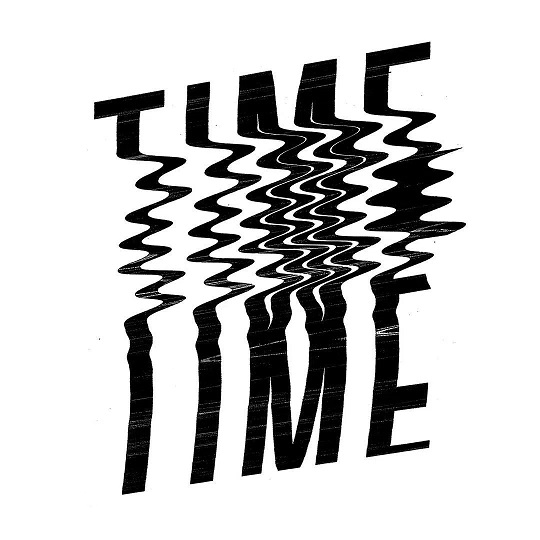
What would you say are the 3 most important topics that you want to address as an artist?
I feel like the topics that I address in my practice evolve and change with time, but at the same time there's some core ideas that transcend the almost 15 years I've been producing art. If I had to pick 3 they would be reality, permanence and the questioning of convention.
What does the word "distortion" means to you Julim? How did it end up being the focal point of your tattoo style?
Distorting a concept, for me, is a way of exploring it. I use distortion to explore what's the meaning of TIME, REALITY, GENDER, NORMALITY or PERMANENCE, for example. It allows me to grab a word and softly make it go through waves, radically glitch it, break it into geometric shapes, or even distort it until the legibility is gone and it turned into a completely abstract composition.
Through distortion I ask questions. I interact with the concept, challenge it's conventional meaning and explore how it makes me feel.
I think it ended up being a distinctive point in my tattoo practice because other people connected to this idea of questioning, and having their own take, their own experience with this process. I help humans create their own personal distortion of a concept and then get it tattooed tailored to their particular body.
I am really interested to know more about your performative work. It is
not something that you see often when it comes to tattoo artistry.
Tattooing appeared in my life around 10 years ago, in a kind-of performative way. Back in Buenos Aires I shared an atelier with a friend and one summer we decided to build a tattoo machine from a tutorial we found online. Using a hair dryer motor, a button, a fork, a pen and a guitar string we built this DIY machine and tattooed each other. This kind of fell into my bigger art exploration, but then I got so fascinated by the permanence and intensity of the tattoo practice that I decided I wanted to really learn it and do it professionally. It was like learning a new media and I fell so deeply in love with it, but art and being a creative person came first, as I know it happened to so many other humans who were artists before tattooing. Maybe every tattoo I do is, in some way, a piece in collaboration with the human that receives it.
Do
you think that there is a discrimination against women's bodies, bodies
with tattoos or bodies in general that you wanted to address with your
performance "Never too much"? I know the answer is probably all 3 but I
am
curious to see which inspired you most in your performance and why.
The performance was inspired by a personal experience of walking around Berlin wearing shorts on one of the first days of summer. I felt so observed. Strangers were making comments about my appearance. This was like a shortcut in my brain to the years I lived in Latin America, where woman and gender non conforming people are constantly harassed, oppressed, discriminated, judged and killed. I remembered feeling so much shame, guilt, sadness. So at this point I decided I wanted to make a statement and take it to the extreme.
I did a performance in the window of a gallery, where I was standing naked for 1 hour, and all I was doing was covering my body completely with tattoo stencils. I felt really exposed, but also super empowered.
It felt like asking society "What happens when I transcend the limits of what you expect from me? Who determines what is "right" and "acceptable" when we are talking about my body?
It happened in Berlin but I was streaming it on Instagram Live to the rest of the world. The action ended with the message "Do what you need to feel at home in YOUR body".

